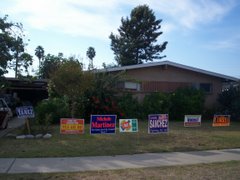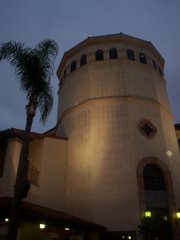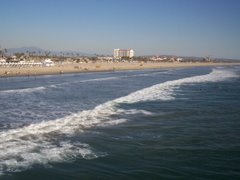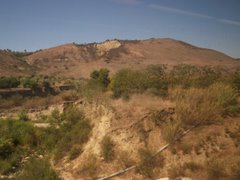
(Photo courtesy KTTV/FOX 11)
We've been warned that this may happen. We've been warned about the blazing infernos to come if we don't change our ways. We've been told that one of the nasty effects of the climate crisis may be an increased risk of wildfires, but not enough of us were listening. But now, the warning is becoming reality. And what we're seeing out in Santiago Canyon (and Malibu, Lake Arrowhead, Santa Clarita, and North San Diego County) may just be the beginning of this new threat of megafires being fueled by our inaction in stopping the climate crisis.
Don't believe me? Well, let's talk about it some more after the flip...
OK, so you want to talk? Well, let's begin with this report published last year on Science Daily:
In the most systematic analysis to date of recent changes in forest fire activity, Anthony Westerling, Hugo Hidalgo and Dan Cayan of Scripps Oceanography, along with Tom Swetnam of the University of Arizona, compiled a database of recent large western wildfires since 1970 and compared it with climate and land-surface data from the region. The results show that large wildfire activity increased "suddenly and dramatically" in the 1980s with longer wildfire seasons and an increased number and more potent wildfires. [...]
"The increase in large wildfires appears to be another part of a chain of reactions to climate warming," said Cayan, a coauthor of the paper and director of Scripps' Climate Research Division. "The recent ramp-up is likely, in part, caused by natural fluctuations, but evidence is mounting that anthropogenic effects have been contributing to warmer winters and springs in recent decades."
Now I can already hear nay-sayers scream that this is all "natural fluctuation", and that we really have nothing to worry about. However, let's take a closer look at what the researchers at Scripps and The University of Arizona are actually trying to say. It's not as simple as just "natural fluctuation".
The researchers determined that year-to-year changes in wildfire frequency appear "to be strongly linked to annual spring and summer" temperatures with "many more wildfires burning in hotter years than in cooler years."
They established a strong association between early arrivals of the spring snowmelt in the mountainous regions and the incidence of large forest fires. An earlier snowmelt, they said, can lead to an earlier and longer dry season, which provides greater opportunities for large fires. Overall, 56 percent of the wildfires and 72 percent of the total area burned occurred in early snowmelt years. By contrast, years when snowmelt happened much later than average had only 11 percent of the wildfires and 4 percent of the total area burned.
And so far, scientific evidence is showing us that increased global temperatures are tied to increased CO2 emissions into the atmosphere. Come on, how much clearer can it be? So long as we allow the climate crisis to worsen, we will be seeing more extreme weather.
Today, I noticed this story in The Toronto Globe & Mail. It amazed me that I found some good perspective behind some troubling local news in a foreign newspaper. But whatever, at least they're willing to tell it like it is.
The short answer is that while some of the contributing factors are long familiar, two closely interwoven others - climate change and a steady U.S. migration to the western states - are not. Even by its own arid standards, the Golden State and much of the Southwest has just experienced an unprecedented summer heat wave, shrivelling crops and lawns and turning always-dry terrain into a blast furnace.[...]
Even more ominous, certainly for those who live in Southern California and the Southwest, is the evolution of a hotter planet, now manifest everywhere from the Arctic to southern Europe.
Compounding the threat is the fact that despite soaring temperatures, Americans continue to head south and west.
Since 1990, an estimated eight million new homes have been built in the western U.S. states, chiefly in areas described as "the urban-wild land interface," code for uprooted city dwellers, many retired, who live in big houses or near pristine forests and deserts.
Those eight million buildings house at least 20 million new western residents.
Oh yes, how can we forget that that we're still making this problem worse?! So long as we continue to ignore the climate crisis, and so long as we ignore possible solutions that can help us grow smarter and more sustainably, we'll only be providing more fuel for more deadly infernos in the future. If we want to save our community and our planet for future generations, we must begin changing our destructive behaviors NOW.
OK, so what does that mean? It means we start rethinking "development", and we start developing "sustainable communities" that are more energy-efficient, more pedestrian and transit-friendly, and less wasteful overall. It means that we stop living such wasteful lives, and that we live more efficiently. It means that we start thinking of new ways to power our lives and our world, and that we get serious about investing in clean alternatives to fossil fuels. It means that our society become more aware of our planet and its finite resources, and that our society becomes a better steward of these finite yet magnificent resources for future generations.
Now I know that it may sound difficult, but it's really not. In fact, it can be as simple as organizing a neighborhood carpool to take the kids to school and/or changing your old light bulbs with new CFC bulbs. It can be as simple as not buying so much bottled water and/or taking the train to work instead of driving. Really, we just need to start making simple lifestyle changes in order to begin the real, moumental change that must take place in order for us to save our planet.
How many more stories like this must we see in the paper before we wake up and smell the looming disaster? How much longer do we want to remain willingly ignorant of the real problem of climate change? How many more "megafires" must we endure before we understand the big factor behind these fires? And how much longer will we wait before we start to make change and stop this crisis?









No comments:
Post a Comment